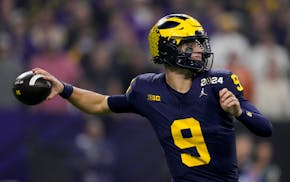You stood at the bottom of the Alps, head tilted back, staring toward the sky. High above — there, that speck, with the sun glinting off her goggles — was Lindsey Vonn, hurtling at an improbable speed and angle.
You sat in Williams Arena as the Lynx played for one more championship and saw Maya Moore hit the kind of contesting, floating shot that you'd never want to see a lesser player attempt, and it went in and the Lynx won and it felt like Moore's highlights would play on a continuous loop for years to come.
In the past few days, Vonn has skied into retirement and Moore has announced she will not play in 2019, while signing a contract so she can return to the Lynx in 2020.
At the end of the week that included National Girls and Women in Sports Day, let's recognize the importance of this news.
Vonn is the greatest female athlete ever produced by the state of Minnesota. And that sentence might be one word too long.
Moore ranks as one of the greatest athletes ever to play for a Minnesota team. And that phrasing might be too cautious.
We are seeing the end of one great career and an interruption of another, with no guarantee that Moore or the Lynx will ever be the same even if she returns.
Instead of mourning their decisions, let's celebrate their careers, and what they meant to Minnesota.
Vonn grew up in the southern suburbs and learned to ski at Buck Hill. That is a story worth savoring. The woman who would become the world's best skier, who would dominate competitors who grew up on the Alps, started schussing amid skiers who define the sport as "falling down and then getting hot chocolate."
She moved to Colorado and became an international superstar. If there was a flaw in her résumé, it was that her aggressiveness led to frequent crashes. She won one Olympic gold medal, becoming the first American woman to win an Olympic downhill, and two bronzes. Those who pay attention to skiing only during the Olympics might not realize how dominant she was during the rest of her career.
Vonn is one of two women to win four World Cup overall championships. She won a record eight World Cup season titles in the downhill, five in the super-G and three straight in the combined.
She won 20 World Cup crystal globe titles, the most ever for a woman or a man. She is one of six women to win World Cup races in all five Alpine disciplines. She set a record for women with 82 World Cup victories.
Minnesota has produced Hall of Fame baseball, football and basketball players, none of whom can boast what Vonn can: that she was perhaps the greatest ever in a sport.
Unlike Vonn, Moore wasn't born in Minnesota, but she is the greatest winner Minnesota has seen. She was the best high school player in America, then the best college player in the country while helping UConn dominate the sport. She became one of the best players on the dominant U.S. Olympic team, and her overseas teams won as often as her UConn teams. She won four WNBA titles in her first seven seasons.
Vonn is considering a career as an actor or business owner. Moore is dedicating herself to "ministry dreams" and time with her family.
They share little other than connections to Minnesota, but they do have commonalities.
Both are powerfully built athletes. Both had little choice but to prove their toughness — Vonn by recovering from falls and injuries, Moore by playing year-round against teams intent on physical play.
Vonn's Instagram posts of her bruises and rehab workouts, and the massive ice packs worn by Moore after every game, displayed the costs of global competition. Greatness charges a toll.
This sentiment is offered too often and too easily but sometimes it is true: Our state might never see anything like them again.
Jim Souhan's podcast can be heard at TalkNorth.com. On Twitter: @SouhanStrib E-mail: jsouhan@startribune.com

Souhan: Wolves fans made Game 1 special. Now bring on Game 2.

Souhan: Should Vikings even consider McCarthy in NFL draft?

Souhan: NAW erases Suns' lead, Game 1 advantage with big performance

Souhan: This is KAT's chance to prove Flip Saunders was right


